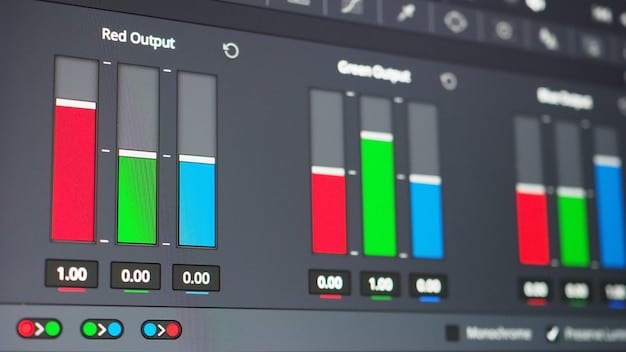The Ultimate Guide to PC Game Streaming: Dominate 2025

The Ultimate Guide to PC Game Streaming in 2025 provides a comprehensive overview of how to maximize viewership and earnings, covering essential hardware, software, and strategies for success in the competitive streaming landscape.
Ready to become a top-tier streamer in 2025? This ultimate guide to PC game streaming: reach more viewers and earn more in 2025 walks you through every step, from setting up your gear to engaging your audience and monetizing your content.
Choosing the Right Streaming Hardware
Selecting the appropriate hardware is the cornerstone of a successful PC game streaming setup. High-quality components ensure smooth streams and an engaging viewing experience for your audience. Investing in the right gear from the outset can save you time and money in the long run.
Let’s explore the essential hardware components you’ll need.
CPU and GPU Considerations
Your CPU and GPU are the workhorses of your streaming setup. The CPU handles encoding, while the GPU renders the game. A powerful CPU, like the AMD Ryzen 7 or Intel Core i7, is crucial for encoding without impacting game performance. Similarly, a robust GPU, such as the NVIDIA GeForce RTX series or AMD Radeon RX series, ensures high frame rates and visual fidelity.
Webcams and Microphones
A high-quality webcam allows you to connect with your audience on a personal level. Look for webcams with at least 1080p resolution and good low-light performance. A dedicated microphone, rather than a headset mic, provides superior audio quality. Condenser microphones like the Blue Yeti are popular choices for their clarity and versatility.
- CPU: AMD Ryzen 7 or Intel Core i7
- GPU: NVIDIA GeForce RTX series or AMD Radeon RX series
- Webcam: 1080p resolution with good low-light performance
- Microphone: Condenser microphone (e.g., Blue Yeti)
Investing in reliable hardware lays a solid foundation for your streaming career, allowing you to deliver consistent high-quality content. With the right equipment, you can focus on creating engaging streams and building a loyal audience.
Optimizing Your Streaming Software
Selecting and configuring the right streaming software is paramount for delivering a polished and professional broadcast. The software you choose will handle encoding, overlays, alerts, and more. Two of the most popular options are OBS Studio and Streamlabs Desktop.
Let’s dive into how to make the most of these tools.
OBS Studio vs. Streamlabs Desktop
OBS Studio is a free, open-source software widely favored for its flexibility and extensive plugin support. It offers granular control over every aspect of your stream. Streamlabs Desktop, built on OBS, provides a more streamlined experience with built-in themes, alerts, and widgets.
Configuring Bitrate and Resolution
Bitrate and resolution are critical settings that determine the quality of your stream. A higher bitrate results in better video quality but requires more bandwidth. Common settings include 1080p at 60fps with a bitrate of 6000-8000 kbps for high-end PCs and 720p at 30fps with 3000-4000 kbps for PCs with lower specifications. Always test your settings to ensure a smooth stream without buffering.

Mastering your streaming software is key to producing professional and engaging streams. By fine-tuning your settings and leveraging the available features, you can create a broadcast that captivates your audience and keeps them coming back for more.
Engaging with Your Audience
Building a strong community is essential for long-term success. Engaging with your audience fosters loyalty and creates a welcoming environment that encourages viewers to return. Interaction can take many forms, from responding to chat messages to hosting interactive events.
Here’s how to create a vibrant community around your stream.
Responding to Chat and Comments
Actively monitoring and responding to chat messages shows your audience that you value their presence. Acknowledge viewers by name, answer their questions, and participate in discussions. Using chat bots can help moderate the chat and provide automated responses to common queries.
Hosting Interactive Events
Interactive events, such as viewer-led games or Q&A sessions, can significantly boost engagement. Allow viewers to vote on in-game decisions, request specific challenges, or ask questions about your gaming setup or personal experiences. These events create a sense of shared experience and strengthen community bonds.
- Chat Engagement: Acknowledge viewers by name and answer questions.
- Interactive Events: Host viewer-led games or Q&A sessions.
- Use Chat Bots: Automate responses and moderate the chat.
Engaging with your audience is about more than just broadcasting gameplay; it’s about building relationships. By actively participating in the community, you can create a loyal following that supports your streaming endeavors.
Monetizing Your Stream
Turning your passion for gaming into a revenue stream requires a strategic approach. There are several avenues to explore, including direct donations, subscriptions, sponsorships, and merchandise sales. Diversifying your income streams can provide financial stability and allow you to invest in improving your stream.
Let’s explore key monetization strategies.
Donations and Subscriptions
Direct donations, typically facilitated through platforms like Streamlabs or Patreon, allow viewers to directly support your stream. Subscriptions on Twitch provide recurring revenue, offering viewers exclusive perks such as emotes, ad-free viewing, and subscriber-only chat. Offering tiered subscription levels can cater to different levels of support.
Sponsorships and Merchandise
Sponsorships involve partnering with brands to promote their products or services during your stream. This can include showcasing hardware, software, or gaming accessories. Merchandise sales, such as branded apparel or accessories, offer another income stream and allow your fans to support you while representing your brand.

Monetizing your stream effectively requires a balanced approach. By offering value to your audience and building strong relationships with sponsors, you can create a sustainable income that allows you to continue pursuing your passion. Experiment with different strategies to find what works best for you and your community.
Leveraging Social Media
Promoting your stream on social media is essential for expanding your reach and attracting new viewers. Platforms like Twitter, Instagram, and YouTube can be powerful tools for sharing highlights, engaging with your audience, and announcing upcoming streams. Consistent and strategic social media activity can significantly boost your visibility.
Here’s how to use social media to grow your stream.
Creating Engaging Content
Share stream highlights, funny moments, and behind-the-scenes content on social media. Create visually appealing posts and videos that capture the essence of your stream and entice viewers to tune in. Use relevant hashtags and tag other streamers or brands to increase visibility.
Announcing Upcoming Streams
Regularly announce your upcoming streams on social media, providing details about the game, any special events, and the start time. Use eye-catching graphics and compelling descriptions to grab attention. Consider using scheduling tools to automate your social media posts and ensure consistent promotion.
- Share Highlights: Post stream highlights and funny moments.
- Announce Streams: Regularly announce upcoming streams with details.
- Use Hashtags: Utilize relevant hashtags to increase visibility.
Effective social media promotion is about more than just posting links; it’s about creating a compelling narrative around your stream. By consistently engaging with your audience and sharing valuable content, you can build a strong social media presence that drives traffic to your stream and grows your community.
Staying Ahead of Streaming Trends
The world of game streaming is constantly evolving, with new platforms, games, and technologies emerging regularly. Staying informed about the latest trends and adapting your strategy accordingly is crucial for maintaining relevance and attracting new viewers. This includes keeping an eye on new game releases, emerging streaming platforms, and innovative engagement techniques.
Let’s explore how to stay ahead in this dynamic landscape.
Monitoring New Platforms and Games
Keep track of new streaming platforms and games that are gaining popularity. Experiment with streaming on different platforms to reach new audiences. Similarly, streaming popular new games can attract viewers who are searching for content related to those titles.
Adopting New Technologies
Embrace new technologies that can enhance your stream, such as virtual reality (VR) streaming, augmented reality (AR) overlays, or advanced audio processing tools. These technologies can set your stream apart and provide a unique viewing experience.
Staying ahead of streaming trends requires a proactive and adaptable approach. By continuously learning and experimenting with new strategies, you can ensure that your stream remains fresh, engaging, and relevant to your audience.
| Key Point | Brief Description |
|---|---|
| 🖥️ Hardware Setup | Choose the right CPU, GPU, webcam, and microphone for optimal streaming quality. |
| ⚙️ Software Optimization | Configure OBS Studio or Streamlabs Desktop with the correct bitrate and resolution. |
| 🤝 Audience Engagement | Interact with viewers in chat and host interactive events to build a community. |
| 💰 Monetization | Utilize donations, subscriptions, sponsorships, and merchandise to earn revenue from streaming. |
FAQ
▼
The essential hardware includes a powerful CPU (e.g., AMD Ryzen 7), a dedicated GPU (e.g., NVIDIA GeForce RTX), a high-quality webcam (1080p), and a condenser microphone for clear audio.
▼
Optimize your software by setting the correct bitrate and resolution. For high-end PCs, use 1080p at 60fps with 6000-8000 kbps. Adjust the audio settings to reduce noise.
▼
Engage by responding to chat messages, hosting interactive events like viewer-led games, and using chat bots to moderate the chat and provide automated responses to common queries.
▼
Monetize through direct donations on platforms like Streamlabs, subscriptions on Twitch, sponsorships from brands, and selling branded merchandise to your viewers to support you.
▼
Social media is very important. Share highlights, announce upcoming streams, and use relevant hashtags to increase visibility. Engage with the community to drive traffic to the stream, which helps grow the community.
Conclusion
By mastering the art of PC game streaming, you can cultivate a thriving community, generate revenue, and share your passion with the world. Embrace these strategies, stay adaptable, and continuously strive to enhance your streams to stand out in the ever-evolving landscape of online entertainment.





